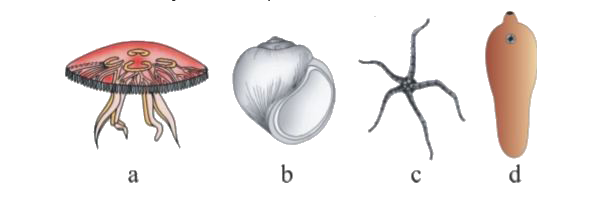Which of the following animal is radially symmetrical but has a bilaterally symmetrical larva.
Ascaris (Round worm)
Nereis (Ring worm)
Pila (Apple snail)
Asterias (Star fish)
The correct Answer is:D
To solve the question "Which of the following animal is radially symmetrical but has a bilaterally symmetrical larva?", we can follow these steps:
Step 1: Understand the Definitions
- Radial Symmetry: An organism is radially symmetrical if it can be divided into similar halves by multiple planes passing through a central axis. Examples include jellyfish and sea stars.
- Bilateral Symmetry: An organism is bilaterally symmetrical if it can be divided into two identical halves along one plane, typically the left and right sides. Examples include humans and most animals.
Step 2: Analyze the Given Options
1. Ascaris (Roundworm): This organism exhibits bilateral symmetry throughout its life cycle, including its larval stage.
2. Ringworm: This is a fungal infection and not an animal, but if we consider the term in a biological context, it typically refers to organisms that also exhibit bilateral symmetry.
3. Apple Snail: This organism also shows bilateral symmetry in both adult and larval stages.
4. Asterias (Starfish): This organism exhibits radial symmetry as an adult but has a bilaterally symmetrical larval stage.
Step 3: Identify the Correct Answer
From the analysis, the only organism that fits the criteria of being radially symmetrical as an adult but having a bilaterally symmetrical larva is Asterias (Starfish).
Conclusion
The correct answer is Option 4: Asterias.
---
- Radial Symmetry: An organism is radially symmetrical if it can be divided into similar halves by multiple planes passing through a central axis. Examples include jellyfish and sea stars.
- Bilateral Symmetry: An organism is bilaterally symmetrical if it can be divided into two identical halves along one plane, typically the left and right sides. Examples include humans and most animals.
1. Ascaris (Roundworm): This organism exhibits bilateral symmetry throughout its life cycle, including its larval stage.
2. Ringworm: This is a fungal infection and not an animal, but if we consider the term in a biological context, it typically refers to organisms that also exhibit bilateral symmetry.
3. Apple Snail: This organism also shows bilateral symmetry in both adult and larval stages.
4. Asterias (Starfish): This organism exhibits radial symmetry as an adult but has a bilaterally symmetrical larval stage.
From the analysis, the only organism that fits the criteria of being radially symmetrical as an adult but having a bilaterally symmetrical larva is Asterias (Starfish).
The correct answer is Option 4: Asterias.
Topper's Solved these Questions
- ANIMAL KINGDOMBOOK - MOTIONCHAPTER - ANIMAL KINGDOMEXERCISE - EXERCISE -2(NCERT Based Questions) ANALYTICAL QUESTIONS
20 Videos
- ANIMAL KINGDOMBOOK - MOTIONCHAPTER - ANIMAL KINGDOMEXERCISE - EXERCISE -3 (AIPMT & NEET Previous Year Questions) AIPMT - 2006
7 Videos
- ANIMAL KINGDOMBOOK - MOTIONCHAPTER - ANIMAL KINGDOMEXERCISE - EXERCISE -1(Objective Problems) CHORDATES
64 Videos
- ANATOMY OF FLOWERING PLANTSBOOK - MOTIONCHAPTER - ANATOMY OF FLOWERING PLANTSEXERCISE - Excercise - 4 AIIMS | Assertion & Reason Questions
34 Videos
- BIOLOGICAL CLASSIFICATIONBOOK - MOTIONCHAPTER - BIOLOGICAL CLASSIFICATIONEXERCISE - CHECK YOUR CONCEPTS-4
13 Videos
Similar Questions
Knowledge Check
Which of the following animals are radial symmetrical ?
 Aa & bBb & dCc & dDa & c
Aa & bBb & dCc & dDa & cWhich one of the following animal is radiallyl symmetrical.
ASyconBEuspongiaCAdamsiaDAll of the aboveWhich of the following organisms is radially symmetrical?
APilaBEchinusCCucumariaDBoth (B) and (C )
Which of the following relations is not symmetric?
View SolutionAn animal phylum having radially symmetrical abults but bilateral symmetrical larve is
View SolutionWhich of the following is a constitutionally symmetrical ether?
View SolutionThe adult ……... are radially symmetrical but larvae are bilaterally symmetrical .
View SolutionWhich of the following phylum have radially symmetrical organisms?
View Solution
